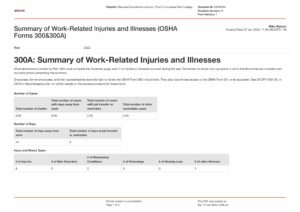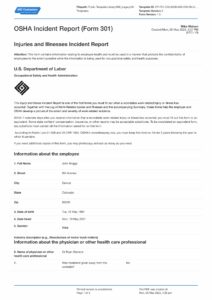Posts by Nick Chernih
Dashpivot article page – OSHA 300 log example
OSHA 300 log example In this article, we’ll show a clear and practical OSHA 300 log example, explain its purpose and how it’s critical for OSHA compliance, and then provide you with some usable resources for your own OSHA 300 logs. What is OSHA 300? The OSHA 300 log is part of the larger OSHA…
Read more →Dashpivot article page – OSHA Form 301 Requirements
OSHA Form 301 Requirements What is OSHA Form 301? OSHA (Occupational Safety & Health Administration) Form 301 is a form used for recording injuries and illnesses that occur in the workplace. It is part of OSHA’s recordkeeping requirements, and it is used by employers to track and document workplace-related injuries and illnesses. Why do you…
Read more →Dashpivot article page – OSHA Heavy Equipment Inspection Requirements
OSHA Heavy Equipment Inspection Requirements In this article, we’ll discuss OSHA heavy equipment inspection requirements, including the key safety standards, inspection checklists, and best practices to ensure compliance and operator safety to conduct thorough inspections, maintain equipment, and reduce the risk of accidents or violations in the workplace. What are your OSHA heavy equipment inspection…
Read more →Dashpivot article page – Snag list vs punch list
Snag list vs punch list In this article, we do a proper snag list vs. punch list comparison, so that you know and can explain the difference. What’s a snag list? The main purpose of a snag list is to ensure the project build meets the contract expectations. A snag, or snagging list, is typically…
Read more →Dashpivot article page – Method Statement and Risk Assessment
Method Statement & Risk Assessment What is a Risk Assessment? Risk Assessments are designed to simplify how risks are captured, managed and tracked. Risk Assessment Registers focus more on risks, communicating those risks to workers on site and the controls needed to manage the risks. How does a Method Statement fit in? Method Statements are…
Read more →Dashpivot article page – RAMS Risk Assessment Method Statement example
RAMS Risk Assessment Method Statement example What is a Risk Assessment Method Statement (RAMS)? RAMS are an important document for the safety and compliance for construction, engineering and other high-risk work environments. Construction sites have inherent risks and potential hazards, and it’s imperative for your teams’ safety that these risks and hazards are properly identified…
Read more →Article Page – Construction Job Hazard Analysis example
Construction Job Hazard Analysis example – Use, copy or customise these examples This article provides a practical Construction Job Hazard Analysis (JHA) example and additional resources that you can use, copy, or edit for your own works to break down tasks, spot hazards, and plan safe work practices. What is a construction Job Hazard Analysis?…
Read more →



